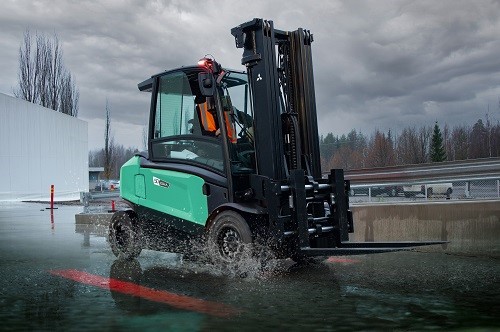Designers of electric forklift trucks are continuously innovating in a bid to make the equipment safer to operate.
Features
Forklift safety: getting better by design
Improvements in forklift truck safety don’t follow a continuous upwards curve. Rather, innovations seem to come in clusters as manufacturers are inspired by competitor developments and seek to incorporate and build upon them.
So, if you’ve not reviewed the marketplace recently, you’ll find we are in the midst of a particularly productive phase with a lot happening to make your handling equipment not only safer but a great deal smarter.
This article focuses largely on electric forklifts and warehouse equipment. That’s partly because of the huge shift in buying patterns from diesel to electric but also because electric trucks have massively eclipsed their rivals in terms of safety features.
 Photograph: Mitsubishi Forklift Trucks
Photograph: Mitsubishi Forklift Trucks
Controlling the curve
Surprisingly perhaps, the most remarkable and far-reaching strides have been achieved by software engineers.
Some years ago, a leading manufacturer created a stability system designed to improve safety during turning manoeuvres. It sensed the speed and angle of a truck in the middle of a turn and adjusted the speed accordingly.
That development has been eclipsed by a system that makes more refined calculations at the very start of the turn, automatically adjusting truck speed to optimise speed throughout the entire curve, optimising speed and safety. It results in greater throughput while making handling feel entirely natural to the operator – so they retain the impression of being in complete control. And, as we’ll see, that matters.
A further development has effectively overcome the centrifugal forces that are created by the weight of the counterweight as a forklift leaves a tight, high-speed turn. Those forces – as the truck straightens – can cause loss of grip at the rear-end of the truck and can even overturn the vehicle.
The solution lies in a new traction speed cutback system which subtly controls drive wheel speed and steering angle sufficiently to minimise the centrifugal forces, doing it in a way that feels entirely natural to the operator (so they don’t feel they are fighting with the machine).
Indeed, the software on some trucks is now closer to top-end electric cars than traditional forklifts, automatically adapting/adjusting every performance characteristic to suit the driving style and ability of each individual operator.
Get a grip!
After years of research into truck design and performance, a Dutch expert in materials handling came to the conclusion that the single biggest factor in maximising both productivity and safety is predictability. The operator performs best in the sure knowledge that the truck will perform exactly as they expect at all times, with no surprises.
As already discussed, some of this can be achieved through software engineering – as long as it is totally unobtrusive. That said, a great deal also depends on innovative thinking in terms of mechanical engineering. This is particularly true as electric trucks are increasingly used for outdoor operations and in environments where floor/ground conditions can be unpredictable.
 Ben Haseley, managing director, Red Diamond Distribution
Ben Haseley, managing director, Red Diamond Distribution
In these circumstances all-wheel steering delivers two distinct wins.
On trucks where the front wheel drive motors work independently and can turn in different directions, grip is greatly improved. One manufacturer has gone a step further by introducing the first electric diff lock which ensures both front motors spin the wheels simultaneously. This is especially useful in slippery conditions when the rear wheels are not straight and also in tight spaces where the steering angle is limited.
Making safety fool-proof
Incorporating new safety measures is one thing, but making sure they work in the real world is another. Forklift operators have a reputation for circumnavigating or even disabling devices they deem unnecessary.
A classic example is seat belts. All too often operators simply can’t be bothered to buckle up, especially in on-off applications. Even where safety systems are fitted, operators routinely attempt to trick them by fastening their seat belts permanently behind them.
Required by law other than in exceptional circumstances they are an absolute lifesaver in tip-over (mousetrapping) incidents. Indeed, tipping accidents were recently confirmed as the single most common cause of operator fatalities (42 per cent) among forklift operators.
To ensure operators comply, there are now trucks out there that feature ‘no-cheat’ seatbelt systems. Unless a required sequence is completed the truck cannot be driven and the hydraulics will not function.
Sometimes the smallest things can have the greatest impact and while you may not be able to change an operator’s natural instincts, you can make a life-or-death difference by ensuring seatbelts are worn.
Another safety system now quite commonplace in the market is a seat interlock which prevents the use of any functions unless the operator is safely seated. This has been a game-changer in reducing accidents where operators or engineers have reached through the mast to operate the hydraulics (lift/lower, etc.).
Note: it’s important to make regular inspections to ensure the seat switch has not been disabled.
Two more innovations worth a mention are auto-braking and load sensing in the hydraulic system. The first of these automatically applies the handbrake when the operator’s foot leaves the accelerator and holds the truck stationary, even on hills (automatic hill-hold).
Load sensing in the hydraulics ensures that the truck’s load handling functions react similarly to different load weights across the entire capacity range (so there are no surprises).
But the designers of forklifts can only do so much.
Separation saves lives
Since prevention is better than cure, the single most effective action you can take to enhance safety is to separate forklifts from those on foot (pedestrians account for almost two in three of all injuries involving forklifts).
There is a host of ways of achieving this, from restricting access to areas where trucks are working to allow only essential personnel, to installing barriers, floor markings etc. The UK Material Handling Association (UKMHA) has produced excellent – and independent – guidance on this.
Similarly, Mitsubishi Forklift Trucks offers a series of downloadable resources including a site survey form to help businesses work safer and also signposts to relevant HSE publications and other sites offering guidance on working smarter and more cost-effectively.
Ben Haseley is managing director at Red Diamond Distribution
For more information see: mitsubishi-forklift.co.uk
FEATURES

Sedentary working and how to combat the ‘sitting disease’
By Gavin Bradley, Active Working on 05 April 2024
Prolonged and excessive sitting poses a major risk to our health, but the Get Britain Standing campaign and On Your Feet Britain Day on 25 April are a great way of encouraging workers to sit less and move more.

Company culture and wellbeing: a crucial link
By Bex Moorhouse, Invigorate Spaces on 05 April 2024
Investing in measures to support worker wellbeing will be ineffective unless the company culture genuinely incorporates values like teamwork, involvement, flexibility and innovation.

Office design and culture: happier and healthier staff – or the opposite?
By Guy Osmond, Osmond Ergonomics on 03 April 2024
Applying ergonomic principles to workstation set-ups and ensuring the physical environment supports neurodivergent people are just some of the ways of creating an office where everyone can thrive, but a supportive and positive organisational culture is vital too.


